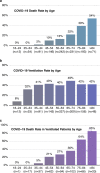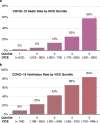This is a preprint.
Estimating Risk of Mechanical Ventilation and Mortality Among Adult COVID-19 patients Admitted to Mass General Brigham: The VICE and DICE Scores
- PMID: 32995802
- PMCID: PMC7523141
- DOI: 10.1101/2020.09.14.20194670
Estimating Risk of Mechanical Ventilation and Mortality Among Adult COVID-19 patients Admitted to Mass General Brigham: The VICE and DICE Scores
Update in
-
Estimating risk of mechanical ventilation and in-hospital mortality among adult COVID-19 patients admitted to Mass General Brigham: The VICE and DICE scores.EClinicalMedicine. 2021 Mar;33:100765. doi: 10.1016/j.eclinm.2021.100765. Epub 2021 Feb 25. EClinicalMedicine. 2021. PMID: 33655204 Free PMC article.
Abstract
Background: Risk stratification of COVID-19 patients upon hospital admission is key for their successful treatment and efficient utilization of hospital resources.
Objective: To evaluate the risk factors associated with ventilation need and mortality.
Design, setting and participants: We established a retrospective cohort of COVID-19 patients from Mass General Brigham hospitals. Demographic, clinical, and admission laboratory data were obtained from electronic medical records of patients admitted to hospital with laboratory-confirmed COVID-19 before May 19th, 2020. Using patients admitted to Massachusetts General Hospital (MGH, derivation cohort), multivariable logistic regression analyses were used to construct the Ventilation in COVID Estimator (VICE) and Death in COVID Estimator (DICE) risk scores.
Measurements: The primary outcomes were ventilation status and death.
Results: The entire cohort included 1042 patients (median age, 64 years; 56.8% male). The derivation and validation cohorts for the risk scores included 578 and 464 patients, respectively. We found seven factors to be independently predictive for ventilation requirement (diabetes mellitus, dyspnea, alanine aminotransferase, troponin, C-reactive protein, neutrophil-lymphocyte ratio, and lactate dehydrogenase), and 10 factors to be predictors of in-hospital mortality (age, sex, diabetes mellitus, chronic statin use, albumin, C-reactive protein, neutrophil-lymphocyte ratio, mean corpuscular volume, platelet count, and procalcitonin). Using these factors, we constructed the VICE and DICE risk scores, which performed with C-statistics of at least 0.8 in our cohorts. Importantly, the chronic use of a statin was associated with protection against death due to COVID-19. The VICE and DICE score calculators have been placed on an interactive website freely available to the public (https://covid-calculator.com/).
Limitations: One potential limitation is the modest sample sizes in both our derivation and validation cohorts.
Conclusion: The risk scores developed in this study may help clinicians more appropriately determine which COVID-19 patients will need to be managed with greater intensity.
Figures



References
-
- University JH. Coronavirus Resource Center. https://coronavirus.jhu.edu/. Published 2020. Accessed.
Publication types
Grants and funding
LinkOut - more resources
Full Text Sources
Research Materials
